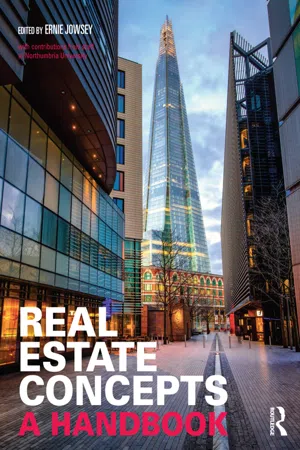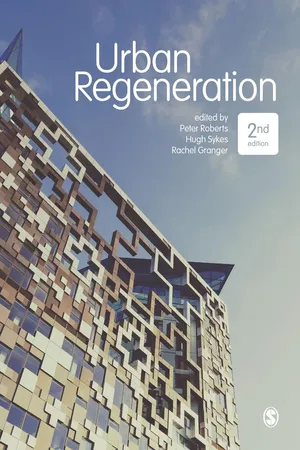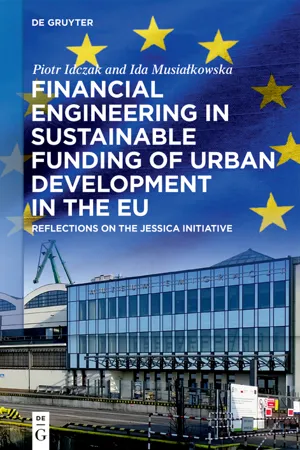Geography
Regeneration Case Studies
Regeneration case studies refer to specific examples of urban or rural areas that have undergone revitalization and redevelopment efforts. These studies analyze the strategies, challenges, and outcomes of regeneration projects, providing valuable insights for understanding the complexities of sustainable development and urban renewal. By examining these case studies, geographers and urban planners can gain a deeper understanding of the factors that contribute to successful regeneration initiatives.
Written by Perlego with AI-assistance
Related key terms
Related key terms
1 of 4
Related key terms
1 of 3
5 Key excerpts on "Regeneration Case Studies"
- eBook - ePub
Real Estate Concepts
A Handbook
- Ernie Jowsey, Ernie Jowsey(Authors)
- 2014(Publication Date)
- Routledge(Publisher)
14 Regeneration Julie Clarke, Hannah Furness, Paul Greenhalgh, Rachel Kirk and David McGuinness 14.1 Defining urban regenerationKey terms: urban regeneration; neighbourhood renewal; area-based initiatives; multiple deprivationRegeneration is a term that is widely misused and misunderstood. It means different things to different people, and can range from large-scale activities that promote economic growth, to neighbourhood interventions that improve people’s quality of life. Fundamentally, it is a holistic process of reversing economic, social and physical decline in areas where market forces alone will not suffice. Holistic regeneration may be conceptualised as a stool, the three legs of which represent physical, economic and social aspects, without any one of which the stool will fall over.Urban regeneration as an idea encapsulates both the perception of a town or city in decline and the hope of renewal, reversing trends in order to find a new basis for economic growth and social well-being. It may be defined as a comprehensive and integrated vision and action that leads to the resolution of urban problems and that seeks to bring about a lasting improvement in the economic, physical, social and environmental condition of an area that has been subject to change (Roberts and Sykes, 2000).Physical regeneration is work on the physical fabric of an area where such work forms part of a strategy to promote social, physical and economic improvements in a given locality, rather than just redevelopment driven solely by market forces (Commission for Racial Equality, 2007). It is necessary to clearly distinguish physical regeneration activity from redevelopment; the latter has arguably been occurring ever since urban settlements existed. It is the process of recycling or reusing land that has already been developed, and may involve demolition, land remediation and reclamation, rebuilding, rehabilitation, conversion and change of use etc. To be considered to be physical regeneration, a project must have some public sector input or intervention that results in it making a contribution beyond the delivery of profitable or worthwhile property development. - eBook - ePub
Planning, Risk and Property Development
Urban regeneration in England, France and the Netherlands
- Nikos Karadimitriou, Claudio de Magalhães, Roelof Verhage(Authors)
- 2013(Publication Date)
- Routledge(Publisher)
Figure 3.2 ) focuses on dynamics, on the interplay between structure and agency and on the relation between the content/objectives of the project, its context and its organisation. Crucially, in an era when property development has been a major driver behind regeneration initiatives, the uncertainty and risk embedded in the property development process will be a key underlying factor behind the strategies of the actors engaging in regeneration schemes.The relation between processes of urban regeneration and the economic, geographic, social and institutional contexts within which any form of organised activity occurs largely influences its chances of success. An organisation, be it a development corporation, a partnership or a property development firm will not survive within a specific context (or environment) if it is not suitably adapted to that environment. Seen from another angle, any form of organised human endeavour is a product of its time, created to fit certain circumstances and tackle era-specific issues in ways specific to the socio-economic environment of that era. As the issues and the institutional structures within which actors operate change with time, so the focus of an organisation needs to change in order to survive and thrive (Meyer and Davis, 2003).Regeneration is influenced by a variety of policy discourses and frameworks at the international, national and local levels that influence the regulatory aspect of state intervention and private or third sector involvement and eventually translate into socio-spatial configurations. In most societies policy frameworks are the outcome of a negotiation process involving a variety of stakeholders such as investors, developers, planners, politicians and local communities, to name a few, each with their own interests to promote. When these frameworks are then applied in concrete local situations they are renegotiated and re-interpreted by the actors directly involved with local polity (Henderson et al - eBook - ePub
- Peter Roberts, Hugh Sykes, Rachel Granger, Peter Roberts, Hugh Sykes, Rachel Granger(Authors)
- 2016(Publication Date)
- SAGE Publications Ltd(Publisher)
Further adjustments to the form and operation of urban policy occurred in the 1990s, with a gradual move back to a more consensual style of politics and the recognition of new problems and challenges. This change in stance has continued to influence the form and content of urban policy. One example of the new policy direction, which is evident both in the general domain of politics and in urban policy, is the acceptance of the need to work in accord with the environmental objectives of sustainable development. Although not yet fully reflected in what we now define as urban regeneration, this is a clear illustration of the way in which the inheritance of the past and the challenges of the present have helped to shape urban regeneration. Although the new challenge of environmentally sustainable development has not yet fully imposed its characteristics on the overall functioning of urban areas, there is little doubt that it will dominate the theory and practice of urban regeneration and urban management in the future. In the interim, at least in the United Kingdom and other advanced nations, the consequences of the economic crisis of the first decade of this century have dominated much of policy and practice.The new contextual conditions in which regeneration is now situated reflect both the causes of, and the responses to, the economic collapse of 2008. As regards causes, regeneration could be seen as a contributor to the crisis: it stimulated and fed on the ready availability of funding, often provided with inadequate security and predicated in part on a continuously upward spiral of property values. In terms of response, the restrictions imposed on public and private sources of funding have caused both the reconsideration of regeneration policy and the adjustment of practice: public funding and public agency support have changed dramatically; private lending is generally only available if capital assets exist and communities have increasingly taken responsibility for regeneration. As Jones and Evans emphasise, the recession ‘is the most dramatic example of how regeneration is tied into broader economic and social processes’ (Jones and Evans, 2013: 9). - eBook - ePub
Financial Engineering in Sustainable Funding of Urban Development in the EU
Reflections on the JESSICA Initiative
- Piotr Idczak, Ida Musiałkowska(Authors)
- 2022(Publication Date)
- De Gruyter(Publisher)
de Magalhães, 2015 ). Regeneration interventions realise the need to counter localised market failures and to achieve an equity objective (regarded as social cohesion). These actions lead to attaining additional social, economic and environmental outputs and outcomes which would otherwise not have occurred or which would have been yielded at an unsatisfactory level.Of particular importance in this context is a holistic approach. This stipulates that any regeneration initiatives should be implemented by bringing a wide range of social, economic and environmental considerations into the decision-making process on an integrated programme of urban development. The idea considers the regeneration programme as relating to a complete city system, and rejects a piecemeal approach. To address the issues resulting from this comprehensiveness, the needs and aspirations of local residents to redevelop their locality are supposed to be met in the wake of the coordination of a number of private and public sector actions (Couch, Sykes, & Börstinghaus, 2011 ). Moreover, the formulation of solutions to the problems of deprived urban area residents and people living in the neighbourhood should take place by way of a common vision, agreed objectives and priorities, pooled expertise and common decisions for the allocation of resources. In this respect it should also be underlined that, following de Magalhães’s view (2015) , the core understanding of what socio-economic decline in cities means must be seen as social, economic and environmental problems of a city (locality) rather than as social, economic and environmental problems that happened to take place in that locality. Therefore urban regeneration through holistic approach policies seeks to address the problems of cities in all their multiple dimensions. It is then characterised by agendas of inclusiveness, multi-agency partnerships, and a shift from government to governance (J. Evans & Jones, 2008 - eBook - ePub
Fitting into Place?
Class and Gender Geographies and Temporalities
- Yvette Taylor(Author)
- 2016(Publication Date)
- Routledge(Publisher)
The (mis)management of resources and uneven effects suggests again the vulnerabilities of particular people and places within the logics of regeneration/degeneration. Spatial segregations are renewed rather than seamlessly transformed, where, for example, rural regenerations mean something quite different from urban regeneration – in the case of ex-mining communities this included being ranked as ‘deprived’ and being in receipt of European Social Funds to simply ‘get by’ rather than to get ahead culturally or economically. Regeneration as a policy itself produces spatialised orientations of and for accumulative, ‘active’ citizens as opposed to more ‘pragmatic’ citizens, with the latter often being absented from ideas of ‘city publics’ (Watson 2006, Back 2007): such orientations, as dispositions and feelings, are disproportionately aligned and/or at odds with regional change. Even well-resourced residential and leisure areas were at times positioned as going too far, as material improvements was repositioned as a loss by and for middle-class subjects who could articulate a claim as losing out, being ‘crowded out’ by the wrong kind of ‘influx’; often this middle-class claim was expressed an aesthetic degeneration of their landscapes. This chapter explores the moral and material positions of ‘improvement’ and the proximities and distances that are invoked through, for, and by ‘improving’ people/ places. Distance invokes both time and place and certain geographical locations were viewed as moving too fast, colliding past and present terrain, in becoming something different: such changes were variously perceived as assets or failures in ‘crowding out’ the once protected, authentic, middle-class terrain
Index pages curate the most relevant extracts from our library of academic textbooks. They’ve been created using an in-house natural language model (NLM), each adding context and meaning to key research topics.
Explore more topic indexes
Explore more topic indexes
1 of 6
Explore more topic indexes
1 of 4




